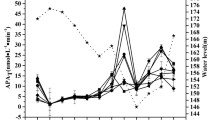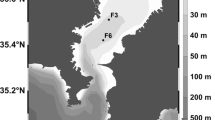Abstract
Extracellular phosphatase can be produced by phytoplankton to utilize organic phosphorus under phosphorus (P) deficiency. However, there is a controversy about its use as an indicator of P deficiency in natural phytoplankton community inferred by such an “induction–repression” mechanism. Size-fractionation of alkaline phosphatase activity (APA), soluble reactive phosphorus (SRP) concentration, algal density, and composition were determined in six Chinese shallow lakes ranking in gradient of trophic status, where a positive relationship between SRP concentration and algal density was observed. Enzyme-labeled fluorescence (ELF) method was used to localize phosphatase on cell membrane of algae. The so-called algal APA that associated with coarser particle (>3.0 µm) accounted for the largest part of total APA. Within a lake with lower SRP concentration, the “induction–repression” mechanism held true. Contrastingly, both algal and total APA were positively related to SRP concentration based on the data across all study lakes with statistical significance, which may be explained firstly by algal composition. The lakes with higher SRP concentration were dominated by diatoms and green algae, while they easily produced extracellular phosphatases as evidenced by ELFA labeling. In parallel, the lakes with lower SRP concentration were dominated by cyanobacteria, while it was never ELFA-positive; secondly, ELFA-positive dots or structures suggested that, in lakes with higher trophic status, attached bacteria or heterotrophic microorganisms could substantially contribute to extracellular phosphatases for hydrolyzing organophosphoric compounds but probably utilizing the organic moiety as an organic carbon source. This process simultaneously produces inorganic P, leading to the co-occurrence of high phosphate concentration and APA. So, the contributor of APA are complex, which may produce extracellular phosphatase species-specific or not exclusively for P nutrient and consequently make it difficult to normalize APA with the exact biomass estimators. Therefore, it is not reasonable to use APA, normalized or not, as a general indicator for describing P deficiency of phytoplankton in shallow lakes especially eutrophic ones.







Similar content being viewed by others
Explore related subjects
Discover the latest articles and news from researchers in related subjects, suggested using machine learning.References
Berman T (1970) Alkaline phosphatases and phosphorus availability in Lake Kinneret. Limnol Oceanogr 15:663–674
Boon PI (1989) Organic matter degradation and nutrient regeneration in Australian freshwaters: I. Methods for exoenzyme assays in turbid aquatic environments. Arch Hydrobiol 115:339–359
Burkholder JM, Wetzel RG, Klomparens KL (1990) Direct comparison of phosphate uptake by adnate and loosely attached microalgae within an intact biofilm matrix. Appl Environ Microbiol 56:2882–2890
Cao X, Štrojsová A, Znachor P, Zapomělová E, Liu G, Vrba J, Zhou Y (2005) Detection of extracellular phosphatases in natural spring phytoplankton of a shallow eutrophic lake (Donghu, China). Eur J Phycol 40:251–285 doi:10.1080/09670260500192760
Chrost RJ, Siuda W (2006) Microbial production, utilization, and enzymatic degradation of organic matter in the upper trophogenic layer in the pelagial zone of lakes along a eutrophication gradient. Limnol Oceanogr 51:749–762
Chrost RJ, Siuda W, Halemejko GZ (1984) Longterm studies on alkaline phosphatase activity (APA) in a lake with fish-aquaculture in relation to lake eutrophication and phosphorus cycle. Arch Hydrobiol 70:1–32
Cotner JB, Wetzel RG (1991) 5′-nucleotidase activity in a eutrophic lake and an oligotrophic lake. Appl Environ Microbiol 57:1306–1312
Deng P, Ma J, Wu X, Gao Y, Cheng S, He F (2007) Dynamics of phytoplankton in the process of the aquatic macrophyte rehabilitation in Lake Yuehu (Wuhan). J Lake Sci 19:552–557 in Chinese
Feuillade J, Feuillade M, Blanc P (1990) Alkaline phosphatase activity fluctuations and associated factors in a eutrophic lake dominated by Oscillatoria rubescens. Hydrobiologia 207:233–240 doi:10.1007/BF00041461
Gage MA, Gorham E (1985) Alkaline phosphatase activity as an index of phosphorus status of phytoplankton in Minnesota lakes. Freshw Biol 15:227–233 doi:10.1111/j.1365-2427.1985.tb00195.x
Gillor O, Hadas O, Post AF, Belkin S (2002) Phosphorus bioavailability monitoring by a bioluminescent cyanobacterial sensor strain. J Phycol 38:107–115 doi:10.1046/j.1529-8817.2002.01069.x
González JM, Sherr BF, Sherr EB (1993) Digestive enzyme activity as a quantitative measure of protistan grazing: the acid lysozyme assay for bacterivory. Mar Ecol Prog 100:197–206 doi:10.3354/meps100197
Healey FP, Hendzel LL (1980) Physiological indicators of nutrient deficiency in lake phytoplankton. Can J Fish Aquat Sci 37:442–453 doi:10.1139/f80-058
Hino S (1988) Fluctuation of algal alkaline phosphatase activity and the possible mechanisms of hydrolysis of dissolved organic phosphorus in Lake Barato. Hydrobiologia 157:77–84 doi:10.1007/BF00008812
Hu HY, Li RY, Wei YX, Zhu CZ, Chen JY, Shi ZX (1980) Freshwater algae in China. Science Technology, Shanghai (in Chinese)
Istvanovics V, Pettersson K, Pierson D, Bell R (1992) Evaluation of phosphorus deficiency indicators for summer phytoplankton in Lake Erken. Limnol Oceanogr 37:890–900
Jamet D, Amblard C, Devaux J (1997) Seasonal changes in alkaline phosphatase activity of bacteria and microalgae in Lake Pavin (Massif Central, France). Hydrobiologia 347:185–195 doi:10.1023/A:1003044008455
Jamet D, Amblard C, Devaux J (2001) Size-fractionated alkaline phosphatase activity in the hypereutrophic Villerest reservoir (Roanne, France). Water Environ Res 73:132–141 doi:10.2175/106143001X138787
Jansson M, Olsson H, Pettersson K (1988) Phosphatases: origin, characteristics and function in lakes. Hydrobiologia 170:157–175
Jones JG (1972) Studies on freshwater bacteria: association with algae and alkaline phosphatase activity. Ecol 60:59–75 doi:10.2307/2258040
Karner M, Ferrier-Pages C, Rassoulzadegan F (1994) Phagotrophic nanoflagellates contribute to occurrence of α-glucosidase and aminopeptidase in marine environments. Mar Ecol Prog 114:237–244 doi:10.3354/meps114237
Krystyna K (1997) Eutrophication processes in a shallow, macrophyte dominated lake—alkaline-phosphatase activity in Lake Łuknajno (Poland). Hydrobiologia 342–343:395–399 doi:10.1023/A:1017051726211
Mhamdia BA, Azzouzib A, Elloumic J, Ayadic H, Mhamdia MA, Aleya L (2007) Exchange potentials of phosphorus between sediments and water coupled to alkaline phosphatase activity and environmental factors in an oligo-mesotrophic reservoir. C R Biol 330:419–428 doi:10.1016/j.crvi.2007.02.009
Murphy J, Riley P (1962) A modified single solution method for the determination of phosphate in natural waters. Anal Chim Acta 27:31–36 doi:10.1016/S0003-2670(00)88444-5
Nagata T, Kirchman DL (1992) Release of macromolecular organic complexes by heterotrophic marine flagellates. Mar Ecol Prog 83:233–240 doi:10.3354/meps083233
Nedoma J, Štrojsová A, Vrba J, Komárková J, Šimek K (2003) Extracellular phosphatase activity of natural plankton studied with ELF97 phosphate: fluorescence quantification and labelling kinetics. Environ Microbiol 5:462–472 doi:10.1046/j.1462-2920.2003.00431.x
Nedoma J, Garcia JC, Comerma M, Simek K, Armengol J (2006) Extracellular phosphatases in a Mediterranean reservoir: seasonal, spatial and kinetic heterogeneity. Freshw Biol 51:1264–1276 doi:10.1111/j.1365-2427.2006.01566.x
Newman S, Mccormick PV, Backus J (2003) Phosphatase activity as an early warning indicator of wetland eutrophication: problems and prospects. J Appl Phycol 15:45–59 doi:10.1023/A:1022971204435
Nicholson D, Dyhrman S, Chavez F, Paytan A (2006) Alkaline phosphatase activity in the phytoplankton communities of Monterey Bay and San Francisco Bay. Limnol Oceanogr 51:874–883
Olsson H (1990) Phosphatase activity in relation to phytoplankton composition and pH in Swedish lakes. Freshw Biol 23:353–362 doi:10.1111/j.1365-2427.1990.tb00277.x
Pettersson K (1985) The availability of phosphorus and the species composition of the spring phytoplankton in Lake Erken. Int Rev Gesamten Hydrobiol Hydrograph 70:527–546 doi:10.1002/iroh.19850700407
Pick FR (1987) Interpretations of alkaline phosphatase activity in Lake Ontario. Can J Fish Aquat Sci 44:2087–2094 doi:10.1139/f87-258
Rejmankova E, Komarkova JA (2000) function of cyanobacterial mats in phosphorus-limited tropical wetlands. Hydrobiologia 431:135–153 doi:10.1023/A:1004011318643
Rengefors K, Pettersson K, Blenckner T, Anderson DM (2001) Species-specific alkaline phosphatase activity in freshwater spring phytoplankton: application of a novel method. J Plankton Res 23:435–443 doi:10.1093/plankt/23.4.435
Rengefors K, Ruttenberg KC, Haupert CL, Taylor C, Howes BL (2003) Experimental investigation of taxon-specific response of alkaline phosphatase activity in natural freshwater phytoplankton. Limnol Oceanogr 48:1167–1175
Reynolds CS (1997) Vegetation processes in the pelagic: a model for ecosystem theory. Ecology Institute, Oldendorf/Luhe
Rose C, Axler RP (1997) Uses of alkaline phosphatase activity in evaluating phytoplankton community phosphorus deficiency. Hydrobiologia 361:145–156 doi:10.1023/A:1003178502883
Sebastian M, Aristegui J, Montero MF, Niell FX (2004) Kinetics of alkaline phosphatase activity, and effect of phosphate enrichment: a case study in the NW African upwelling region. Mar Ecol Prog Ser 270:1–13 doi:10.3354/meps270001
Šimek K, Vrba J, Lavrentyev P (1994) Estimates of protozoan bacterivory: from microscopy to ectoenzyme assay? Mar Microb Food Webs 8:71–85
Smith RIH, Kalff J (1981) The effect of phosphorus limitation of algal growth rate: evidence from alkaline phosphatase. Can J Fish Aquat Sci 38:1421–1427 doi:10.1139/f81-188
Spijkerman E, Coesel PFM (1998) Alkaline phosphatase activity in two planktonic desmid species and the possible role of an extracellular envelope. Freshw Biol 39:503–513 doi:10.1046/j.1365-2427.1998.00299.x
Štrojsová A, Vrba J, Nedoma J, Komárková J, Znachor P (2003) Seasonal study on expression of extracellular phosphatases in the phytoplankton of an eutrophic reservoir. Eur J Phycol 38:295–306 doi:10.1080/09670260310001612628
Štrojsová A, Vrba J, Nedoma J, Šimek K (2005) Extracellular phosphatase activity of freshwater phytoplankton exposed to different in situ phosphorus concentrations. Mar Freshw Res 56:417–424 doi:10.1071/MF04283
Taga N, Kobori H (1978) Phosphatase activity in eutrophic Tokyo Bay. J. Mar Biol (Berl) 49:223–229 doi:10.1007/BF00391134
Tanaka T, Henriksen P, Lignell R, Olli K, Seppala J, Tamminen T, Thingstad TF (2006) Specific affinity for phosphate uptake and specific alkaline phosphatase activity as diagnostic tools for detecting P-limited phytoplankton and bacteria. Estuaries Coasts 29:1226–1241
Thingstad TF, Zweifel UL, Rassoulzadegan F (1998) P limitation of heterotrophic bacteria and phytoplankton in the northwest Mediterranean. Limnol Oceanogr 43:88–94
Vaitomaa J, Repka S, Saari L, Tallberg P, Horppila J, Sivonen K (2002) Aminopeptidase and phosphatase activities in basins of Lake Hiidenvesi dominated by cyanobacteria and in laboratory grown Anabaena. Freshw Biol 47:1582–1593 doi:10.1046/j.1365-2427.2002.00901.x
Vrba J, Komárková J, Vyhnálek V (1993a) Enhanced activity of alkaline phosphatases—phytoplankton response to epilimnetic phosphorus depletion. Water Sci Technol 28:15–24
Vrba J, Šimek K, Nedoma J, Hartman P (1993b) 4-methylumbelliferyl-β-N-acetylglucosaminide hydrolysis by a high-affinity enzyme, a putative marker of protozoan bacterivory. Appl Environ Microbiol 59:3091–3101
Wang H (2007) Predictive limnological researches on small- to medium-sized lakes along the Mid-lower Yangtze River. Doctoral Dissertation 119 (in Chinese)
Wilczek S, Wörner U, Pusch MT, Fischer H (2007) Role of suspended particles for extracellular enzyme activity and biotic control of pelagic bacterial populations in the large lowland river Elbe. Fundam Appl Limnol 169:153–168 doi:10.1127/1863-9135/2007/0169-0153
Zubkov MV, Sleigh MA (1998) Heterotrophic nanoplankton biomass measured by a glucosaminidase assay. FEMS Microbiol Ecol 25:97–109 doi:10.1016/S0168-6496(97)00086-X
Acknowledgments
This work was partly supported from the following projects: the National Key Basic Research and Development Program (2008CB418006), 30600088 from the National Science Foundation of China, and KZCX2-YW-426 from the Chinese Academy of Sciences.
Author information
Authors and Affiliations
Corresponding author
Rights and permissions
About this article
Cite this article
Cao, X., Song, C. & Zhou, Y. Limitations of using extracellular alkaline phosphatase activities as a general indicator for describing P deficiency of phytoplankton in Chinese shallow lakes. J Appl Phycol 22, 33–41 (2010). https://doi.org/10.1007/s10811-009-9422-0
Received:
Revised:
Accepted:
Published:
Issue Date:
DOI: https://doi.org/10.1007/s10811-009-9422-0




